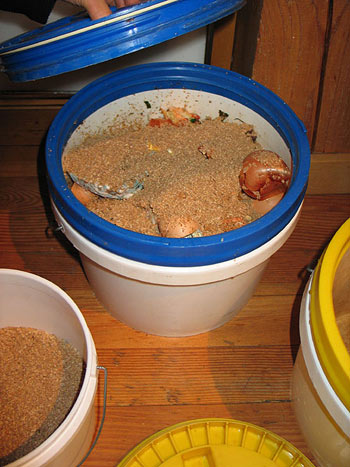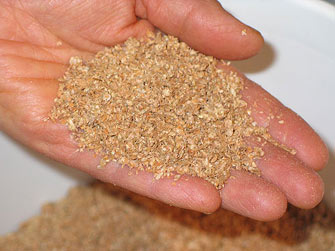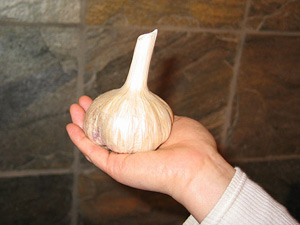Using EM Bokashi in Composting on Saltspring Island
By Brian Smallshaw
Saltspring Island
250-653-9778
smallshaw@gmail.com
Bokashi maker/provider in Vancouver, BC, Canada
Great Day Bokashi
Using Bokashi at Home and at the Office
For product information, contact:
Sinja Masahara
Vancouver BC Canada
Tel and Fax: 604-251-7601
I'll give you a brief overview of how we use EM bokashi in composting, together with a few photos.
We have been using bokashi to treat our kitchen compost for about six or seven years, beginning soon after we cleared a spot for our garden here on Saltspring after moving from Tokyo. I won't go into the details of preparing bokashi, except to say that we mix up 100lb batches every summer, or every other summer, and store the dried mixture in a couple of large plastic barrels. We then keep a smaller bucket of bokashi in the kitchen handy for daily use.

Fresh kitchen compost goes into a white, five-gallon plastic bucket, and can include any vegetable matter or leftover cooked food. We avoid putting any meat or dairy products into it, although small amounts of either are no big deal. We also try to avoid putting in large amounts of liquid. After throwing some stuff in the bucket, we give it a liberal dusting with bokashi; probably the equivalent of two or three generous handfuls before putting the lid back on. More compostable material goes in, then more bokash until the bucket is full. In our three-person household we fill a bucket about every five or six days.
When one bucket is filled, we put the lid on and put it outside on our deck and bring in a clean bucket. When the second bucket is filled, we take the first down to the garden and dig it into the soil. It seems that leaving it in the bucket for a few days helps in the decomposition process. To dig it in, I pick an already harvested or fallow bed, dig a hole about a shovel-blade deep, dump in the compost, put a shovelful of dirt on it, mix the two together, and then cover with dirt. The raccoons often come and dig some of it up, but most of it stays in the ground.

We do all of our composting with two plastic buckets reserved for the purpose. To make opening and closing the buckets less of a chore, several years ago we picked up a couple of Gamma Seal lids, an after-market lid that fits on a standard restaurant five-gallon white bucket. Instead of being a snap-fit cap like a standard bucket lid, the Gamma lid spins on like a giant jar lid. This might seem like a small thing, but because it can be taken off and put back on with one hand, it means that you can open the bucket with one hand and fire the compost in with the other, making the process much faster and easier. The Gamma Seal lids are available from Lee Valley for about $10 or $12 each.
Some rather grand claims are made for the bokashi in Japan. Whole towns have taken to using it to manage household waste, and some pretty impressive gardens are being grown with it. The EM bacteria mixture is also used in many other ways such as treating waste water and minimizing odours in livestock operations; here on Saltspring it's being using together with liquid fertilizers in Canada's only organic golf course. Personally, I'm not sure how much better bokashi compost is for your garden than plain-old compost, but I can say that stuff does break down very fast in the soil, and that when I dig in the area a month or two later it is absolutely WRITHING with earthworms. Huge masses of them. I can also quite immodestly brag that the garlic that I grow are absolutely huge, and have taken two blue ribbons at the Fall Fair, on an island where people take garlic growing very, very seriously (see photo!).

On a more basic level, bokashi certainly makes handling kitchen waste a much more palatable chore; instead of having a bucket of rotting vegetables under your sink, you have a bucket of compost that has a kind of 'fermenty' smell; somewhat pungent, but to my nose at least, not particularly objectionable. And if bokashi does nothing more than make kitchen compost easier to handle, I think its all worth it.
EM Bokashi Recipe:
Ingredients
100 lb (20kg X 2 bags) of wheat bran
12 litres of warm water
240 cc of molasses
240 ml of EM
What you'll need
a tarp, or a large, smooth area protected from the rain
a bucket, or a large spray bottle
a large air-tight container, such as an industrial plastic barrel with the lid
1. Spread wheat bran on a big plastic tarp.
A driveway or any other smooth surface would do fine, but you'll want to make sure that you can protect it from rain - we think about these things in rainy British Columbia! With a tarp, you can wrap the whole batch up as a big bundle if rain threatens.
2. Mix the warm water, molasses and EM in a big container.
3. Spray the liquid mixture over the bran with a water jug or a large spray bottle.
4. Mix the bran and the liquid further by hand, crumbling the chunks down until the bran is evenly wetted.
5. Put the mixture in the air-tight barrel. Press it down as you stuff it in to remove as much air as possible.
6. Leave it for about a month in a warm place. (normal room temperature, or slightly warmer if possible)
7. When the surface of the mixture becomes covered with a whitish, fuzzy mold-like material and has a nice (at least for some of us!) sour fermented smell, it's done.
8. The bokashi can be used right away. For longer-term storage, spread the mixture out on your plastic tarp away from direct exposure to sunlight and moisture until it's completely dry. Break up any lumps; the bokashi should be completely granular. This usually takes a couple of days on the warm summer days of our area; in a hotter, drier climate it would presumably happen quite a bit quicker.
9. The dried bokashi should be good for at least two years.
We have unlocked the key of your success for 70-649 vce & exam 70-680 by using our latest 70-647 testlets, 70-640 pdf and exam 70-564.
Happy Composting!

